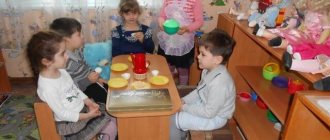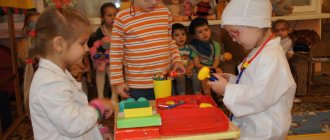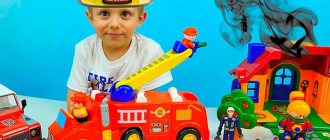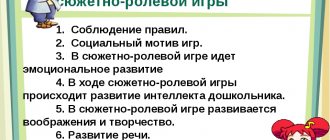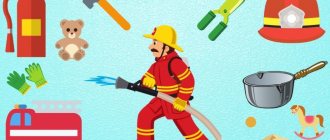Summary of the plot-role-playing game in the preparatory group
Summary of the role-playing game “Journey to the Mysterious Island” in the preparatory group
Author. Makarova Nadezhda Leonidovna, teacher of the MDOU combined type kindergarten No. 30 Kipen, Leningrad region. Description. I offer a summary of the role-playing game “Journey to the Mysterious Island” for children in the preparatory group. This work will be of interest to teachers of preschool institutions who work with children of this age category. The relevance of conducting role-playing games. Role-playing games allow you to develop children's creative abilities and their imagination. In the game, children learn to get used to the image of a particular character and play a certain role. They are of great importance in the social adaptation of the child and the realization of his potential in the future. In the role-playing game, the child’s personality, his intelligence, will, imagination and sociability are successfully developed, but most importantly, the role-playing game generates the desire for self-realization and self-expression. Target. To develop in children the ability to combine various thematic plots into a single game plot; establish and regulate contacts in a joint game. Tasks. 1. Expand the range of children's games, teach them to play together (discuss the plot, come up with new roles and game actions), help create a game environment taking into account the theme of the game and an imaginary situation, teach them to name their role, verbally determine the events depicted, the location of the players (here is the sea , this is a ship, it is sailing to a mysterious island, etc.). 2. Reinforce in children the sequence of days of the week, the number and order of counting, the names of geometric shapes, measuring objects using a conventional measure, and orientation in space. 3. Activate children's vocabulary: cabin, navigator, boatswain, porthole, cook, travel agency, courier, cruise. 4.Develop creative thinking, imagination, and fantasy in children. 5. Cultivate friendly relationships and a sense of teamwork in children. Preliminary work. Examination of photographs, illustrations, pictures depicting various ships. Construction of ships from various building materials and paper. Reading “Native Man” by V. Korzhikov, “Shark” by L. N. Tolstoy. Making attributes for the game. Watching the cartoon "Boniface's Vacation." Conversation after watching the cartoon. Writing stories on the topic: “What if I went on a trip.” Game attributes. Modules for building a ship, seven multi-colored (according to the colors of the rainbow) flags, caps, binoculars, an anchor, small toys from Kinder surprises, a conventional measure - braid, napkins, wallets, money, tickets, a computer, bananas, a cutting board.
Progress of the game.
Educator.
Children, let's play with you.
What game do you want to play? (Children's answers). Educator.
Okay, we're going on a sea cruise!
What will we sail on? (Children offer different options - choose a ship). Educator.
Guys, what day of the week do you think is best to travel?
Why? What is the day of the week called today? (Children's answers). Let's not delay our voyage! Let's go traveling today! Educator.
Let's think about where we're going? (Children's answers. I offer the children seven multi-colored (according to the colors of the rainbow) flags, on one side of each flag a letter is written.) Guys, if you arrange the flags by color in the same order as a rainbow, then you will find out where we will go on the cruise. (Children complete the task and read the word “islands”). Yes, to the islands!
Together with the children, we decide what we need to prepare for the trip and assign roles. We choose an agent to work in a travel agency, a courier to purchase vouchers, a supermarket seller, a supply manager to purchase the necessary goods for the cruise (a set of small toys, wet wipes, four knives). The rest of the children are ship designers (we build the ship from modules). When everything is ready for the trip (tickets have been purchased, goods have been purchased, and most importantly, the ship has been built), the children choose a captain, a navigator, and a cook. The rest of the children will be sailors. Boarding of the ship is announced. The captain checks the tickets, it turns out that the tickets were bought from a travel agency to the “Mysterious Island”. Everyone takes their places on the ship. The captain gives the command to the navigator. The ship departs from the pier (a recording of the sound of the sea and a ship signal sounds). During the journey, children play with their tickets. The tickets are unusual, with tasks. On one side of the ticket you need to count the number of objects, and on the reverse side you need to find the differences in the picture depicting two ships.
So the ship approaches its destination unnoticed, but a problematic situation arises.
There is no ship pier on this island. Educator.
Children, how can you get to the island?
(Children's answers). The captain suggests getting to land using a life preserver. Children imitate swimming with a lifebuoy to the song “Chunga-Changa” by V. Ya. Shainsky and land on the island. On the island we listen to birdsong (a recording of bird voices sounds). Next, the children try to imagine what can grow here, how beautiful it is here. Educator.
Children, it is very hot on the island, you can take off your shoes and walk barefoot on the sand.
(At this time, small toys from Kinder surprises that the children wanted to play with accidentally fell apart.) How can you collect the toys? (Children's answers). Yes, of course, now you and I will turn into monkeys and collect toys with our toes. (Children collect toys with their toes and put them in a basin.) Educator.
Who do you think lives on the island? (Children's answers). We put together a cut-out picture and find out what kind of funny people live here.
Educator.
Children, how can you imagine what kind of home they might have? What might their house be called? (Children's answers). We will now come up with a home for them using these pictures. (The game “Wonderful Things” (TRIZ) is being played. This game can be found in the book “Amazing Stories” by L. E. Belousova. The house is green, made of rubber, four-story, moves on chicken legs, a guitar is always playing in it, the smell of strawberries in the house. We discuss with the children whether it is comfortable to live in such a house. The game “Good - Bad” (TRIZ) is played.)
Educator.
Children, if this island is mysterious, there must be treasures here?
(The game is played: “Find the treasure.” Three children are blindfolded. According to the specified plan, they look for treasures. The plan is voiced by the captain. The children quickly find the treasure, but they cannot open it without guessing the following spell (a recording from a tape recorder sounds): “There are two objects - one of them grows here on the island, the other is in your group and in the music room. Both of these objects begin with one sound and end with a sound, but another. Each word has five sounds. Children guess the word "banana" and the word “tambourine.” A treasure opens (a beautiful antique chest prepared in advance), and there are bananas.) Educator.
Guys, we are on an unusual island, it’s so mysterious, and it’s hot here. Maybe we can turn these bananas into ice cream? (The children happily agree.) Then let's wash our hands first. (A finger game is played. “Wash your big finger, wash your index finger, wash your middle finger, ring finger and small little little finger.” Children wash their fingers using wet wipes. The cook distributes bananas. The children are faced with a problematic situation - there are not enough bananas for everyone. What to do? Children using a conventional measure (braid), divide the bananas in half, then cut, peel, insert an ice cream stick on one side of the banana and roll the banana in cocoa.You get ice cream and everyone treats themselves.
Educator.
Guys, let's take a look at the magic chest where the bananas were. (The children look into the chest, it turns out to have a second bottom. There the children find souvenirs from the inhabitants of the island - jewelry with a shell.) The journey comes to an end. We have to go back to kindergarten. Children close their eyes and say the magic words: “One, two, three, four, five - we are in kindergarten again.” And they end up in a group. They look at their jewelry and plan to go to the mysterious island again, so that next time they can get acquainted with the marine inhabitants of the island.
We recommend watching:
Summary of the plot-role-playing game for children 3-4 years old Summary of open intellectual and physical education leisure in the preparatory group Synopsis of the plot-role-playing game “Zoo” in the middle group Game leisure based on Pushkin’s fairy tales in the preparatory group of the kindergarten
Similar articles:
Summary of a lesson in the preparatory group on the topic: Spring
Playful musical entertainment for children of the preparatory group in kindergarten. Scenario
Spring leisure in the preparatory group. Semik - Russian rite of flowering
Fun in the preparatory group. Russian customs
Fun game for children in the preparatory group of kindergarten
Preparatory group. Senior preschool age. Children 6-7 years old
Seminar for teachers “Cultivating friendships in children of senior preschool age through role-playing games” Nowadays, almost all parents are interested in the early development of their children. The desire to see a child smart and developed is fueled by many scientific works that prove the need for intelligence training in preschool age. Development will be effective if it...
Role-playing game "Mail" in the preparatory group
Goal: improving the ability to unite in a game, distribute roles, perform game actions, act in accordance with the general game plan, develop the plot of the game “Mail”
. Materials and equipment: mailboxes; postman costumes; messenger bags; boxes for...
Preparing for the game "School"
The school environment includes all student paraphernalia: blackboard, desks, rulers, pens, pencils, notebooks, backpacks, pointer and, of course, the school bell. The selection of costumes may be limited to imitation business clothes for teachers and white bows for girl students.
To prepare for the game, it is advisable to visit one of the schools with a group (with the permission of the director) and observe the events in the classrooms, in the corridors during recess, in the cafeteria. You can supplement the acquired knowledge by reading books about school and listening to relevant songs (“It’s fun to walk through the open spaces together,” “Wonderful school years,” etc.).
As a plot, the teacher can choose a number of small scenes in various lessons: Russian language, mathematics, physical education. The bell means the end of one scene and the transition to the next (after a break, of course). It is important to maintain the sequence of dialogues, to give each participant the opportunity to play the role calmly and fully.
Types of plots for theatrical preschool activities
With the help of story plays, kindergarten students acquire basic knowledge about their future life. They can be called a “school of life.” So, educators select stories that are close to the understanding of a 4-5 year old child.
- Everyday home stories cover the following topics: “family”, “birthday celebration”, etc. They are associated with the everyday life of a preschooler and an adult, and are designed to model comfortable relationships between close people - parents, relatives, brothers and sisters.
- The plots of the scenes “going to the library”, “school”, “examination at the clinic” are associated with interaction with surrounding people performing their duties at work. For example, by acting out the “hospital” scene, the student not only acquires knowledge of how to behave during an examination by a doctor, but also observes his professional behavior, gains knowledge about the main attributes of doctors: a white coat, a “listener,” etc. By acting out the scene “hair salon”, girls can try themselves in the role of a beautiful fairy who works miracles. The “bank” plot will allow children to get acquainted with the world of finance, the working atmosphere, and will show the essence of the work of a cashier and operator. "Theater" is full of interesting roles both on stage and behind the scenes. This is how children acquire knowledge about basic professions.
- Stories inspired by cartoon films familiar to all students. Among the popular stories are “Well, wait a minute!”, “Masha and the Bear” and others.
The practice of many kindergartens includes maintaining special cards of role-playing games. They represent an event plan detailing:
- necessary equipment: books, cutlery, equipment;
- interior space: background, furniture, toys;
- costumes of heroes, clothing marking their profession: a chef’s hat, a special apron for a hairdresser, etc.
The use of cards is aimed at preliminary thorough preparation for the event by both educators and preschoolers. Close acquaintance with the students and already accumulated observations regarding their preferences and tastes allow the organizer to choose the most suitable topics for a particular year of study.
